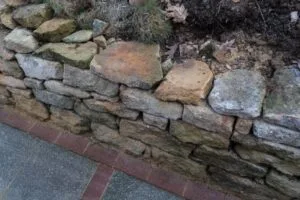Hardscaping solutions offer homeowners excellent ways of adding beauty and function to their yard, and some popular examples of these are stone walls. If you’re planning to add a stone wall to your garden landscaping near White Plains & Westchester County, then read on to learn about the differences between dry-laid and wet-laid varieties.
Structure
The most notable difference that separates wet-laid and dry-laid stone walls is that the former is made using mortar while the latter are not. Both options have advantages. With a wet-laid stone wall, it can be easier to achieve a flat face because mortar is used to keep the stones in place during the construction process. Alternatively, gravity is what holds a dry-laid wall together, and this mortar-free option can be easier to maintain and boast a more natural and rustic appearance than a wet-laid stone wall. Also, wet-laid walls can be more expensive and demand additional prep-work, while dry-laid ones can require unique skills to create.
Flexibility
Wet-laid stone walls are constructed to be rigid, allowing them to retain their shape despite external forces. When built with a solid base, these mortared hardscaping features can often stand the test of time with little wear. However, cracks can eventually form in the mortar and require patching or repair. Dry-laid walls, on the other hand, are designed to be flexible. Because there is no mortar, water drains through the stones easily, and any small shifts or settling that occur typically have no visible impact on the structure.
Repairs
Because of the mortar that is used to hold a wet-laid wall together, any patchwork that is applied to fix cracks is often quite noticeable. Also, repairs that may be required for these structures can blend in poorly and represent a significant undertaking. However, when a dry-laid stone wall fails, its components can be taken apart and reassembled relatively easily, and any repairs often blend in well with the existing wall. Despite their differences, both wet-laid and dry-laid stone walls can add function and natural beauty to your garden design.


